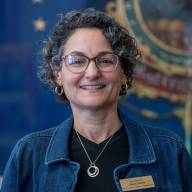The Harwood Unified Union School District (HUUSD) Bond Planning Committee is working on getting a bond re-estimated in light of how significantly costs have changed since 2021 and may also consider creating a net-zero building since Vermont will require net-zero energy buildings by 2030.
Last Wednesday, August 9, 2023, the HUUSD Bond Planning Committee discussed plans for an upcoming bond to fund upgrades at Harwood Union High School. Following the rejection of a $60 million bond vote in 2021, the committee is working to come up with a bond that voters will approve in its next iteration.
A series of public community conversations is planned, noted Superintendent Dr. Mike Leichliter, “and we engage far and wide, we have multiple in-person meetings, we have zoom meetings, and we give our public a chance to really weigh in on this before we put the final details and plans of what should and should not be included in this bond plan.” These meetings will start this November.
Architect David Epstein of TruexCullins reviewed the details of the 2021 bond and noted that, with prices having risen significantly in the meantime, “That’s one of the issues, is that there’s been such rampant price increases that one of the things we’re going to have to do is get the project repriced, re-estimated.”
Epstein noted that the original plan had work divided into four “buckets.” The first was “compliance and repairs,” which included infrastructure issues such as roof, electrical and plumbing repairs, as well as asbestos removal and ensuring the building’s accessibility and code compliance. Second was “efficiencies and improvements,” which would entail replacing the high school’s 1960’s-era windows, installing more efficient LED lighting, and consolidation efforts such as moving the district’s administrative offices and Harwood Community Learning Center program into the high school. This piece of the plan depended on having space to move around as needed throughout the renovation process, with middle school students headed to Crossett Brook – which is now not happening.
Third was “educational alignment,” including the creation of STEM and humanities hubs where students could attend classes and receive support. Also planned was a “team space” for rising ninth graders to aid in students’ transition to high school. Special education services would also be decentralized, decreasing stigma for students receiving these services and allowing pods to be placed throughout the school. Another gym and upgrades to the track and field hockey facilities were also included. The fourth piece of this bond, Epstein explained, was an addition to Crossett Brook Middle School. Without middle school students moving out of Harwood, he added, “swing space” for moving parts would be difficult to find, and other schools in similar situations have used portable classrooms. Epstein anticipated a timescale of roughly two school years and three summers to complete the work.
Leichliter returned to the question of higher cost, recalling a story from his last high school, which had also undergone a significant construction upgrade. He noted that the estimated cost of the work had increased 50% over the course of construction; it cost $100M when it began in 2018, but would have cost $150M in 2022.
Epstein noted that the cost “could be significantly more than the community was asked to support last time.”
School board member Ashley Woods, Warren, observed that “I think we’re going to find a compromise, and I honestly think the communities are going to get it about the money.”
Cam Featherstonehaugh, senior associated at TruexCullins, noted that “the project might be two years of the district budget, but it’s going to service the district for 25 years.” Featherstonehaugh later mused, “What should the building say about us? Should it say that we’re cash-strapped and very institutional? Or can it be that we care about the environment and we care about presentation? And that doesn’t have to cost a lot more.”
Woods suggested that with HVAC projects getting done piecemeal, perhaps air quality might be a separate line item in the project. Epstein pointed out that with global warming, air conditioning might be another consideration – and that this would be a different type of system than one that only provides heating and ventilation.
A suggested conversation concerned the middle school’s space needs, given that the Harwood middle schoolers will not be moving out of their current building. Another question, which HUHS co-principal Laurie Greenberg addressed, regarded the size of the ninth-grade team spaces.
With some of the building’s windows dating back almost 30 years – and others past the half-century mark – Epstein floated the idea of creating a net-zero building. Vermont will require net-zero energy buildings by 2030, Epstein noted. HUUSD staff member Lynda Cummings thought this goal’s elements should receive line items of their own. Cummings added that the numbers presented to the community must be very clear this time around because, she said, confusion during the last bond made people uneasy.
“(T)he more we can break things out, the more they’re going to appreciate that,” Cummings said.
Leichliter suggested that HCLC might move to Harwood from its current home in a separate HUUSD-owned building on nearby Dowsville Road; some staff members could then move to the current HCLC building rather than renting space as they currently do for $50,000 a year. Woods wondered where HCLC could be located, and Greenberg noted that space within the HUHS building could house the program. Board member Kelley Hackett, Waterbury, suggested a line item to highlight cost-saving ideas such as this one. Harwood Director of Finance and Operations Lisa Estler noted that the cost of the space rental is only rising over time.
Featherstonehaugh suggested the possibility of breaking the plans out into small-, medium- and large-ask categories, and Greenberg pointed out that the building might offer a space for the community to pursue art, music, and sports, providing a community resource beyond its purpose as a high school.
Epstein then presented a timeline for coming months. A general scope of work will be in place by October. The first community conversations will entail a broad conversation with community members in November, with cost numbers for various parts of the bond project already in place to share with residents. By mid-January 2024, the board will be discussing what’s been learned from these discussions. Through March, the project’s details will be established in more detail, yielding more specific plans – with cost estimates – to present to the community from April through November 2024.
Next steps included planning a walking tour of the building to examine its challenges and needs, followed by an in-person meeting, and discussing the possibility of creating a video to show the school’s condition.













